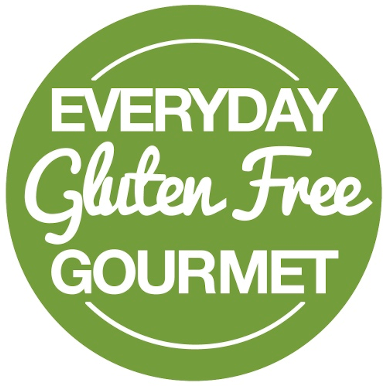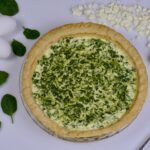The secret to making flaky gluten free pie pastry is to roll out the dough with the least amount of sprinkling flour as possible. One trick is to use plastic wrap or wax paper as you roll. Once you master the technique you'll be the one saying, "it's as easy as pie!"

Pastry is only intimidating because most cooks don't make it often enough to feel good at it. You can become the family pie expert and make all the pastry dishes you want. That's what I did when I needed gluten free pastry for quiche, pot pies, hand pies, whole pies and the French Canadian meat pie, Tourtiere.
Jump to:
🥧 Ingredients
Gluten free bakers need to be open to new ideas and willing to forget what your mom told you about what makes the best pastry. Here are some tips shared by America's Test Kitchen. They do more testing than any home cook could ever do so trust them.
- butter and sour cream - using all butter with sour cream creates a nice workable dough
- rice vinegar - makes a tender pastry (better than either baking soda or lemon juice)
- EGFG gluten free flour blend (sweet rice flour, potato starch, sorghum flour, millet flour)
- sugar
- xanthan gum - important for structure
- sweet rice flour for sprinkling - as little as possible please
See recipe card for exact amounts.
📹 Instructions
I didn't use plastic wrap in this video but I find my students have less trouble making pastry if they use that technique.
🥧 Substitutions
I can't say this enough, no gluten free flour is going to work in every recipe. Plus not every flour blend is going to work for everyone. I use this EGFG gluten free flour blend for the majority of my baking and it works perfectly in this pastry recipe.
If you're not happy with the results of your baking I've got LOTS of help for you. Subscribe to get resources sent to you over a series of emails, take my cooking class that explains gluten free flour or start with this 12-part series, How To Use Rice Flour for gluten free baking.
🥧 Equipment
If you're going to make pastry you might as well get the tools you want. Here are some to consider.
- Not every recipe will work in a deep dish pie plate so a standard pyrex 9-inch pie plate with a fluted edge is inexpensive and essential.
- Every kitchen needs a rolling pin whether it’s a classic wooden rolling pin, a heavy marble one designed to stay cool for working with pastry or a modern silicone style rolling pin.
- Sue Jennett, my friend, baker and podcaster likes a mini rolling pin with handle for smaller pieces of pastry. You can also buy them without a handle, wooden or silicone, they're great for kids too. If you don't know Sue check out A Canadian Celiac Podcast wherever you listen to podcasts.
- Flexible baking mats or inexpensive light weight cutting boards are perfect for flipping pastry to ensure it doesn't stick to the paper on either side when you put it into the pie plate.
🥧 Storage
America's Test Kitchen does not recommend freezing their gluten free pastry. They use a different flour blend (that I don't care for) and many of my readers and students report that this recipe freezes well.
Despite my best intentions I never get back to leftover pieces of dough so I don't freeze them and try not to even keep them in the fridge. I plan to use it up making small tarts or strips of pastry sprinkled with cinnamon sugar or cheese. At every pastry class I ask people what they do with leftover bits of dough and try all their ideas.
💡 Top Tip for Gluten Free Cooks
For gluten free bakers the most important thing to remember about pastry is that some individual recipes have specific tricks that make them work. Pumpkin pie is a great example where you time the pastry to be adding the warm filling to a warm crust. My best advice is to read the recipe from top to bottom before you start baking.
Many of these tips are thanks to America's Test Kitchen. Their cookbooks are an excellent resource and would be a nice gift. I highly recommend any of these.
- ATK: The How Can It Be Gluten Free Cookbook (out of print but still available at libraries, used bookstores and online)
- ATK: Volume 2 The How Can It Be Gluten Free Cookbook.
- A compilation of these (including 75 dairy free recipes) titled, How Can It Be Gluten Free Cookbook Collection: 350+ Groundbreaking Recipes For All Your Favorites.

Flaky Gluten Free Pie Pastry
Ingredients
WET INGREDIENTS
- 6 tablespoon cold water
- 3 tablespoon sour cream
- 1 tablespoon rice vinegar
DRY INGREDIENTS
- 390 grams EGFG gluten free flour blend* (2¾ cups plus 2 Tbsp)
- 1 tablespoon sugar
- ½ teaspoon salt
- ½ teaspoon xanthan gum
- 1 cup cold butter
- sweet rice flour for sprinkling
Instructions
MAKE PASTRY
- Cut butter into ¼-inch pieces and freeze for 15 minutes. Meanwhile measure the wet and dry ingredients separately.
- In 1-cup measuring cup combine water, sour cream and vinegar. Stir and set aside.
- Combine flour, sugar, salt and xanthan gum in the bowl of a food processor. Turn on briefly to combine.
- Add cold butter to processor and turn on until combined into uniform crumb-like mixture with no visible pieces of butter.
- Add sour cream mixture, mix until it looks like dough and is sticking together. If it looks dry continue mixing it.
- Transfer dough to large piece of wax paper. Using your hands mix in any last bits of flour.
- Divide the dough ball into 2 pieces for pie, or smaller pieces as desired for other recipes.
- Place each dough ball onto a piece of wax paper large enough to wrap completely. Flatten pastry into a disk and wrap. Refrigerate for 20 minutes.
ROLLING OUT PASTRY
- Preheat oven as directed in recipe. Remove dough from fridge, unwrap and leave in the center of the wax paper. Top with a second piece of paper to decrease the amount of sprinkling flour needed.
- Using a rolling pin start in the center of the dough, rolling out toward the edges. Lift the rolling pin at the edges. Avoid rolling off the edge of the dough making the edges thinner than the rest of the pastry.
- Use a thin cutting board or flexible cutting mat to support pastry and flip it over. Lift the paper to see how sticky it is. Sprinkle with a small amount of flour only if needed. You want the paper to easily peel off so check both sides. Put the paper back on the dough and continue rolling until you have a large circle about ⅛-inch thick. The circle should be 1 or 2 inches larger than your pie plate.
- Remove wax paper and invert the dough into the pie plate. Working quickly, gently push the edges of the dough into the sloped sides of the pie plate before the pastry cracks. Trim the edges with a knife or scissors.
- To make a thick edge crust tuck the excess dough under itself, crimping the edge into the rim as you go. Alternately, push the dough into the rim of the pan with your thumb and fingers.
- Chill pastry in freezer for 15 minutes before baking.
- Bake according to your recipe.
Notes
My final note is a baking challenge for you. Make pastry once a week or once a month and become the pie expert. Let me know in the comments below if you tried this pastry recipe and if it was as easy as pie!
__________________________________________________________________________
New here? Subscribe and get your FREE resource, the tips I wish I knew when I started cooking gluten free.
Looking for more help with gluten-free cooking? Check out our Cooking Classes.
_________________________________________________________________________



















Cinde
I use this recipe to make Chilean empanadas, a whole tourtiere and even small hand pies. It works every time!
Cinde Little
I just made this pastry recipe using Tenderflake lard for a dairy-free and gluten-free cooking class and it worked perfectly.
June
Awesome 😊 Norma J
Cinde Little
Thanks for letting me know Norma! I just taught that cooking class today and enjoyed a Cherry Hand Pie with this delicious flaky pastry.